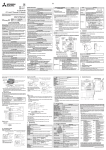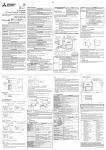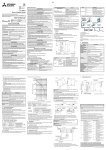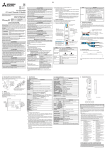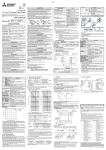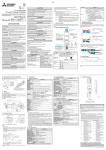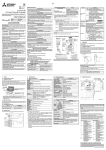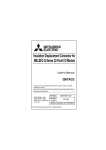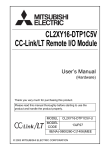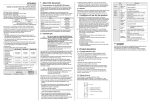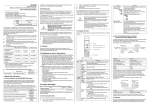Download CL1Y4-T1C2 CC-Link/LT Remote I/O Module User`s Manual
Transcript
Side B ●SAFETY PRECAUTIONS● (Read these precautions before using) Please read this manual carefully and pay special attention to safely in order to handle this product properly. Also pay careful attention to safely and handle the module properly. These precautions apply only to Mitsubishi equipment. Refer to the user’s manual of the CPU module to use for a description of the PLC system safety precautions. These ●SAFETY PRECAUTIONS● classify the safety precautions into two categories: "WARNING" and "CAUTION". Procedures which may lead to a dangerous condition and cause death or serious injury if not carried out properly. [STARTING AND MAINTENANCE PRECAUTIONS] • Do not touch the terminals when the power is ON. It may cause an electric shock or malfunction. • Perform cleaning the module or retightening of terminal screws after turning OFF the all external power supply for sure. Failure to do so may cause failure or malfunction of the modules • Do not disassemble or modify the module. Doing so may cause failure, malfunction, injury, or fire. • The module case is made of resin; do not drop it or subject it to strong shock. A module damage may result. • Make sure to switch all phases of the external power supply OFF before installing or removing the module to/from the panel. Failure to do so may cause failure or malfunction of the modules. 1. Depending on circumstances, procedures indicated by may also be linked to serious results. In any case, it is important to follow the directions for usage. Store this manual in a safe place so that you can take it out and read it whenever necessary. Always forward it to the end user. [DESIGN PRECAUTIONS] • Configure an interlock circuit in a sequence program so that the system operates on the safety side using the communication status information in the event the data link falls into a communication problem. Otherwise, erroneous output and malfunction may result in accidents. • Remote input and output can not be switched ON or OFF when a problem occurs in the remote I/O modules. Therefore build an external monitoring circuit that will monitor any input signals that could cause a serious accident. Outline of Product * Set up using a slotted screwdriver with a tip width of 0.9 mm or less. 3. Connector terminal assignment The CL1Y4-T1C2 can be installed to DIN rail or directly installed using mounting screws. Each installation procedure is described below. 0 1 2 3 Connector for CC-Link/LT interface Status indicator LEDs Output operation indicator LEDs Input is ON: Lit Input is OFF: Extinguished 2-φ4.5 mounting hole (M4 mounting screw) • Do not have control cables and connection cables bundled with or placed near by the main circuit and/or power cables. Wire those cables at least 100mm(3.94 inch) away from the main circuit and/or power cables. It may cause malfunction due to noise interference. • Use the module and the connection cable without applying any force on them. Otherwise, such cables may be broken or fail. [INSTALLATION PRECAUTIONS] • Use the module in an environment that meets the general specifications contained in this manual. Using this module in an environment outside the range of the general specifications could result in electric shock, fire, erroneous operation, and damage to or deterioration of the product. • Do not directly touch the module's conductive parts. Doing so could cause malfunction or trouble in the module. • Tighten the module securely using DIN rail or installation screws within the specified torque range. If the screws are too lose, the module may drop from its installation position, short circuit, or malfunction. If the screws are too tight, the screws may be damaged, which may cause the module to drop from its installation position or short circuit. • Install the module on a flat surface. If the mounting surface has concave and/or convex, an excessive force may be applied on the module, and nonconformity may be caused. 4. Wiring • Authorized Representative in the European Community: Mitsubishi Electric Europe B.V. Gothaer Str. 8, 40880 Ratingen, Germany Standards with which this product complies Type : Programmable Controller (Open Type Equipment) Remote I/O module Models : Products manufactured: from February 1st, 2004 to April 30th, 2006 are compliant with EN61000-6-4 and EN61131-2:1994+A11:1996+A12:2000 after May 1st, 2006 are compliant with EN61131-2:2007 Electromagnetic Compatibility Remark Standards (EMC) EN61000-6-4:2001 Electromagnetic compatibility -Generic standards - Emission standard for Industrial environment EN61131-2:1994/A11:1996/A12:2000 Programmable controllers -Equipment requirements and tests EN61131-2: 2007 Programmable controllers -Equipment requirements and tests 5. Specifications 5.1 General specifications Wire the connector for I/O interface (e-CON) according to the following procedure: Item Ambient working temperature Ambient storage temperature Ambient operating humidity Ambient storage humidity The output terminals of the CL1Y4-T1C2 are fixed to the sink output. CL1Y4-T1C2 Connector for CC-Link/LT interface 1 2 3 4 +24V DA DB 24G Isolation DC DC Interface connector for I/O (sink output) CON1 1 +24V 2 NC 3 NC 4 Y0 CON2 1 +24V 2 NC 3 NC 4 Y1 ... 1 2 3 4 CON4 +24V NC NC Y3 Name 5 to 95%RH: Dew condensation shall not be considered. 5 to 95%RH: Dew condensation shall not be considered. Frequency 10 to 57Hz Acceleration − 57 to 150Hz 9.8m/s2 Number of times of sweep Half amplitude 0.075mm Applicable DIN rail 0 Acceleration 10 times in each of X, Y and Z directions Half amplitude (for 80 min) − TH35-7.5Fe and TH35-7.5AI Width:35mm 3.2 Direct installation ON while the power is supplied. ON while the output is ON. Output operation Extinguished while the output is indicator LEDs OFF. 1 2 Screw-tighten the module by attaching M4 screws to the upper and lower mounting holes (two holes in all) provided in the module. Install the module so that the clearance of 1 to 2mm (0.04" to 0.08") is assured for each module. Applicable screw M4 × 0.7mm(0.03") × 16mm(0.63") or more (Tightening torque range: 0.78 to 1.08 N⋅m) 3 Output operation indicator Connector for CC-Link/LT communication line/module power supply (24G/DB/DA/+24V) Interface 6. Transistor output (Power supply supplied from CC-Link/LT interface) (sink) 4 points Isolation with photocoupler 24V DC Operating load voltage range 20.4 to 28.8V DC (Ripple ratio: Within 5%) Max. load current 0.1A/point, 0.4 A/1 common Max. inrush current 0.4A/10 ms Leakage current at OFF 0.1mA or less Max. voltage drop at ON Response time Outside Dimensions Specification 2 - φ4.5(0.18") mounting hole (M4 mounting screw) 69(2.72") 1.0ms or less ON→OFF 1.0ms or less Surge suppression Zener diode Common wiring method 4 points/1 common (sensor connector 2-wire type) Internal protection for outputs Internal protection circuit none Please connect the fuse in the connected load outside. 23.6(0.93") 10 (0.4") 60.5(2.39")±0.4(0.02") 0.3V or less (typical)/0.1A 0.6V or less (max.)/0.1A OFF→ON − When continuous vibration is present 10 to 57Hz ON ON: When a communication error or DIP switch setting error occurred Flickering at a constant interval: When the setting of the DIP switch was changed while the power was supplied (even while the LED is flickering, the operation continues. The new L ERR. setting becomes valid when the power is turned OFF once, then ON again.) Flickering at a intermittent interval: When a terminal resistor is not attached or when the module or a connection cable is affected by noise Status indicator LED 3) 2) 40 20 10 8 4 2 1 HLD L RUN ON while normal operation is executed. Rated load voltage -25 to 75°C (-13 to 167°F) Frequency DIP switch DIP switch assignment Description PW Status indicator LED Isolation method 57 to 150Hz 4.2 External wiring Connector for I/O interface Terminal arrangement (Pin number and Signal name) Signal Signal Pin No. name Pin No. name 1 +24V 1 +24V Y0 Y1 Y2 Y3 2 NC 2 NC CON1 CON3 3 NC 3 NC 4 Y2 4 Y0 1 +24V 1 +24V C C C C 2 NC 2 NC CON4 CON2 O O O O 3 NC 3 NC N N N N 4 Y3 1 2 3 4 4 Y1 Number of outputs 0 to 55°C (32 to 131°F) 4) Hook for installation to DIN rail Output method Specification Removal 1) Item When intermittent vibration is present Vibration resistance (*1) Installation 5.2 Output specifications 4.1 Connecting and wiring of connector for I/O interface 1) Verify that the plug cover is installed in the plug unit. Caution: Do not push the plug cover into the plug unit before the cable is inserted. Once a plug is pressure-displaced, it can no longer be reused. 2) Insert the cable until it makes contact with the plug unit. - When inserting the cable, confirm that it has been inserted completely. If the cable is not inserted completely, it may cause contact failures. - If the cross section of the cable is not round, the cable cannot be inserted smoothly. Cut the cable tip using pliers, etc., and make is as round as possible, then insert it. - When inserting the cable, the cable may stick out from the front of the cover. In such a case, pull the cable backward so that the tip of the cable stays within the plug cover. 3) Using a pliers or special tool, push the plug cover into the plug unit, and pressure-displace it. After performing pressure displacement, verify that the plug cover is securely attached to the plug unit, as shown in the figure at right. - While performing pressure displacement, the plug cover may rise because it is not latched against the plug unit correctly. This condition indicates that pressure displacement is incomplete. Push the plug cover until it is securely installed in the plug unit. Compliance with all relevant aspects of the standard. (Radiated Emissions and Mains Terminal Voltage Emissions) Compliance with all relevant aspects of the standard. (RF Immunity, Fast transients, ESD and Damped oscillatory wave) Compliance with all relevant aspects of the standard. (Radiated Emissions, Conducted Emissions, Radiated electromagnetic field, Fast transient burst, Electrostatic discharge, High-energy surge, Voltage drops and interruptions, Conducted RF and Power frequency magnetic field) 3.1 Installation to DIN rail DIN rail mounting screw pitch When installing the module to the DIN rail, tighten the mounting screws at the pitch of 200mm(7.87") or less. • During transportation avoid the impact which exceeds a regulated value as the module is a precision instrument. Doing so could cause trouble in the module. • It is necessary to check the operation of module after transportation, in case of any impact damage. Otherwise, causes the damage of the machine and the accident. Note Installation When installing the module, align the upper DIN rail installation groove on the module with the DIN rail 1), and press the module on to the DIN rail 2). When removing the module, pull the hook downward for installation to DIN rail 3), then remove the module 4). • When disposing of this product, treat it as industrial waste. • This product is designed for use in industrial applications. Holds the output (when an error has occurred). ON : Holds the output. OFF : Clears the output. Name and Setting of Each Part and Terminal Arrangement [TRANSPORTATION AND MAINTENANCE PRECAUTIONS] ●Note Concerning the CE Marking● HLD 1 OFF 2. [DISPOSAL PRECAUTIONS] This note does not guarantee that an entire mechanical module produced in accordance with the contents of the notification comply with the following standards. Compliance to EMC standards of the entire mechanical module should be checked by the user / manufacturer. Attention DIP switch as follows. 10's digit 1's digit Station No. 40 20 10 8 4 2 32 OFF ON ON OFF OFF ON This product is an open sensor connector type output module connected to CC-Link/LT. This product has four output points (transistor output). 4 3 2 1 Procedures which may lead to a dangerous condition and cause superficial to medium injury, or physical damage only, if not carried out properly. Zone C = Factory mains which is isolated from public mains by dedicated transformers. Zone B = Dedicated power distribution which is protected by secondary surge pro tection. (300V or le ss in the ra ted vo ltage is assumed.) Zone A = Local power distribution which is isolated from dedicated power distribution by AC/DC converters, isolation transformers, etc. (120V or less in the rated voltage is assumed.) 6.5 (0.26") CL1Y4-T1C2 JY997D10701G April 2015 *1 Zone defined in EN61131-2 Separation defined in EN61131-2 for EMC LVD regulation decided depending on condition in industrial setting. Description sensor connector for connecting output signals Connector for I/O The plug for the connector is an optional. interface The size of the acceptable electric wire is different according to the plug for the connector used. Set the 10's digit of the station No. using "STATION NO. 10", "STATION NO. 20" and "STATION NO. 40". Set the 1's digit of the station No. using "STATION NO. 1", "STATION NO. 2", "STATION NO. 4" and "STATION NO. 8". Factory default = All bits are OFF. Make sure to set the station No. in the range from 1 to 64. If any station No. outside the range from 1 to 64 is set, it is regarded as an error and the L ERR. LED lights. DIP switch * Example: When setting the station No. to "32", set the 6(0.24") User’s Manual • Perform correct wiring for the module according to the product’s rated voltage and terminal arrangement. Connecting to a power supply different from rating or miss-wiring may cause fire, product failure or malfunction. • Make sure foreign objects do not get inside the module, such as dirt and wire chips. It may cause fire, product failure or malfunction. • Attach a warning label (hazard symbol 417-IEC-5036) concerning the electric shock to the location. • Use this product in Zone A*1 as defined in EN61131-2. Name 22(0.87") Please read this manual thoroughly before starting to use the product and handle the product properly. • Perform installation and wiring after disconnecting the power supply at all phases externally. If the power is not disconnected at all phases an electric shock or product damage may result. For more details please contact the local Mitsubishi Electric sales site. • Notes for compliance to EMC regulation. It is necessary to install the CL1 series module in a shielded metal control panel. 49(1.93") CL1Y4-T1C2 CC-Link/LT Remote I/O Module MODEL MANUAL Number Date [WIRING PRECAUTIONS] ENGLISH 41(1.62")±0.4(0.02") JAPANESE 4.5(0.18") B 23.6(0.93") A Side 24G DB DA +24V Side Center of DIN rail Unit: mm(inches) 0.035mm 4.9m/s2 − Impact resistance (*1) 147 m/s2, 3 times in each of X, Y and Z directions Operating atmosphere Corrosive gas shall not be present. Operating altitude 2,000m(6561'8") or less (*2) Installation place Inside control panel (*3) Over-voltage category ΙΙ or less (*4) Degree of contamination 2 or less (*5) Notes: *1 The criterion is shown in IEC61131-2. *2 The module cannot be used in an environment pressurized above the atmospheric pressure which can be generated around the altitude of 0 m. If the module is used in such an environment, it may fail. *3 The module can be used in any environment even outside the control panel as far as the requirements of the ambient operating temperature, the ambient operating humidity, etc. are satisfied. *4 This indicates the section of the power supply to which the equipment is assumed to be connected between the public electrical power distribution network and the machinery within premises. Category ΙΙ applies to equipment for which electrical power is supplied from fixed facilities. The surge voltage withstand level for up to the rated voltage of 300V is 2500V. *5 This index indicates the degree of conductive generating substances in the environment in which the module is used. The degree of contamination 2 indicates that contamination is caused by generation of only non-conductive substances. In this degree, however, temporary conduction may be caused by accidental condensation. 5.3 Performance specifications Item Voltage Module power supply Specification 20.4 to 28.8V DC (24V DC -15% to +20%) Ripple ratio: Within 5% Current consumption 60mA (when all points are ON) Not including external load current Initial current 70mA Max. allowable momentary power PS1:1ms failure period Number of stations occupied 4-, 8- or 16-point mode: 1 station Noise durability 500Vp-p Noise width: 1μs Cycle: 25 to 60 Hz (by noise simulator) Withstand voltage 500V AC for 1 min between primary area (external DC terminal) and secondary area (internal circuit) Isolation resistance 10 MΩ or more between primary area (external DC terminal) and secondary area (internal circuit) by 500V DC megger Protection class IP2X I/O part connection method Connection with terminal block DIN rail installation, mounted by screws of type Module installation method M4 × 0.7mm(0.03") × 16mm(0.63") or larger Can be installed in six directions Mass (weight) 0.04 kg (0.09 lbs) This manual confers no industrial property rights or any rights of any other kind, nor does it confer any patent licenses. Mitsubishi Electric Corporation cannot be held responsible for any problems involving industrial property rights which may occur as a result of using the contents noted in this manual. Warranty Mitsubishi will not be held liable for damage caused by factors found not to be the cause of Mitsubishi; machine damage or lost profits caused by faults in the Mitsubishi products; damage, secondary damage, accident compensation caused by special factors unpredictable by Mitsubishi; damages to products other than Mitsubishi products; and to other duties. For safe use • This product has been manufactured as a general-purpose part for general industries, and has not been designed or manufactured to be incorporated in a device or system used in purposes related to human life. • Before using the product for special purposes such as nuclear power, electric power, aerospace, medicine or passenger movement vehicles, consult with Mitsubishi. • This product has been manufactured under strict quality control. However when installing the product where major accidents or losses could occur if the product fails, install appropriate backup or failsafe functions in the system. Country/Region Sales office/Tel USA Mitsubishi Electric Automation lnc. 500 Corporate Woods Parkway, Vernon Hills, IL 60061, USA Tel : +1-847-478-2100 Brazil MELCO-TEC Representacao Comercial e Assessoria Tecnica Ltda. Av. Paulista, 1439, cj74, Bela Vista, Sao Paulo CEP: 01311-200-SP Brazil Tel : +55-11-3146-2200 Germany Mitsubishi Electric Europe B.V. German Branch Gothaer Strasse 8, D-40880 Ratingen, Germany Tel : +49-2102-486-0 UK Mitsubishi Electric Europe B.V. UK Branch Travellers Lane, Hatfield, Hertfordshire, AL10 8XB, UK. Tel : +44-1707-27-6100 Italy Mitsubishi Electric Europe B.V. Italian Branch Viale Colleoni 7-20864 Agrate Brianza (Milano), Italy Tel : +39-039-60531 Spain Mitsubishi Electric Europe B.V. Spanish Branch Carretera de Rubi 76-80.AC.420, E-08190 Sant Cugat del Valles (Barcelona), Spain Tel : +34-93-565-3131 France Mitsubishi Electric Europe B.V. French Branch 25, Boulevard des Bouvets, F-92741 Nanterre Cedex, France Tel : +33-1-5568-5568 Czech Republic Mitsubishi Electric Europe B.V.-o.s.Czech office Avenir Business Park, Radicka 751/113e, 158 00 Praha5, Czech Republic Tel : +420-251-551-470 Poland Mitsubishi Electric Europe B.V. Polish Branch ul. Krakowska 50, 32-083 Balice, Poland Tel : +48-12-630-47-00 Russia Mitsubishi Electric Europe B.V. Russian Branch St.Petersburg office Piskarevsky pr. 2, bld 2, lit "Sch", BC "Benua", office 720; 195027, St. Petersburg, Russia Tel : +7-812-633-3497 Country/Region Sales office/Tel South Africa CBI-Electric. Private Bag 2016, ZA-1600 Isando, South Africa Tel : +27-11-977-0770 China Mitsubishi Electric Automation (China) Ltd. No.1386 Hongqiao Road, Mitsubishi Electric Automation Center, Changning District, Shanghai, China Tel : +86-21-2322-3030 Taiwan Setsuyo Enterprise Co., Ltd. 6F., No.105, Wugong 3rd Road, Wugu District, New Taipei City 24889, Taiwan, R.O.C. Tel : +886-2-2299-2499 Korea Mitsubishi Electric Automation Korea Co., Ltd. 3F, 1480-6, Gayang-Dong, Gangseo-Gu, Seoul, 157-200, Korea Tel : +82-2-3660-9530 Singapore Mitsubishi Electric Asia Pte, Ltd. Industrial Division 307, Alexandra Road, Mitsubishi Electric Building, Singapore, 159943 Tel : +65-6470-2308 Thailand Mitsubishi Electric Automation (Thailand) Co., Ltd. Bang-Chan Industrial Estate No.111 Soi Serithai 54, T.Kannayao, A.Kannayao, Bangkok 10230 Thailand Tel : +66-2906-3238 Indonesia P. T. Autoteknindo Sumber Makmur Muara Karang Selatan, Block A / Utara No.1 Kav. No. 11, Kawasan Industri Pergudangan, Jakarta-Utara 14440, P.O, Box 5045, Indonesia Tel : +62-21-663-0833 India Mitsubishi Electric India Pvt. Ltd. 2nd Floor, Tower A & B, Cyber Greens, DLF Cyber City, DLF Phase-III, Gurgaon-122002 Haryana, India Tel : +91-124-463-0300 Australia Mitsubishi Electric Australia Pty. Ltd. 348 Victoria Road PO BOX11, Rydalmere, N.S.W 2116, Australia Tel : +61-2-9684-7777 HEAD OFFICE : TOKYO BUILDING, 2-7-3 MARUNOUCHI, CHIYODA-KU, TOKYO 100-8310, JAPAN When exported from Japan, this manual does not require application to the Ministry of Economy, Trade and Industry for service transaction permission. Specifications subject to change without notice. Side B ●SAFETY PRECAUTIONS● (Read these precautions before using) Please read this manual carefully and pay special attention to safely in order to handle this product properly. Also pay careful attention to safely and handle the module properly. These precautions apply only to Mitsubishi equipment. Refer to the user’s manual of the CPU module to use for a description of the PLC system safety precautions. These ●SAFETY PRECAUTIONS● classify the safety precautions into two categories: "WARNING" and "CAUTION". Procedures which may lead to a dangerous condition and cause death or serious injury if not carried out properly. [STARTING AND MAINTENANCE PRECAUTIONS] • Do not touch the terminals when the power is ON. It may cause an electric shock or malfunction. • Perform cleaning the module or retightening of terminal screws after turning OFF the all external power supply for sure. Failure to do so may cause failure or malfunction of the modules • Do not disassemble or modify the module. Doing so may cause failure, malfunction, injury, or fire. • The module case is made of resin; do not drop it or subject it to strong shock. A module damage may result. • Make sure to switch all phases of the external power supply OFF before installing or removing the module to/from the panel. Failure to do so may cause failure or malfunction of the modules. 1. Depending on circumstances, procedures indicated by may also be linked to serious results. In any case, it is important to follow the directions for usage. Store this manual in a safe place so that you can take it out and read it whenever necessary. Always forward it to the end user. [DESIGN PRECAUTIONS] • Configure an interlock circuit in a sequence program so that the system operates on the safety side using the communication status information in the event the data link falls into a communication problem. Otherwise, erroneous output and malfunction may result in accidents. • Remote input and output can not be switched ON or OFF when a problem occurs in the remote I/O modules. Therefore build an external monitoring circuit that will monitor any input signals that could cause a serious accident. Outline of Product * Set up using a slotted screwdriver with a tip width of 0.9 mm or less. 3. Connector terminal assignment The CL1Y4-T1C2 can be installed to DIN rail or directly installed using mounting screws. Each installation procedure is described below. 0 1 2 3 Connector for CC-Link/LT interface Status indicator LEDs Output operation indicator LEDs Input is ON: Lit Input is OFF: Extinguished 2-φ4.5 mounting hole (M4 mounting screw) • Do not have control cables and connection cables bundled with or placed near by the main circuit and/or power cables. Wire those cables at least 100mm(3.94 inch) away from the main circuit and/or power cables. It may cause malfunction due to noise interference. • Use the module and the connection cable without applying any force on them. Otherwise, such cables may be broken or fail. [INSTALLATION PRECAUTIONS] • Use the module in an environment that meets the general specifications contained in this manual. Using this module in an environment outside the range of the general specifications could result in electric shock, fire, erroneous operation, and damage to or deterioration of the product. • Do not directly touch the module's conductive parts. Doing so could cause malfunction or trouble in the module. • Tighten the module securely using DIN rail or installation screws within the specified torque range. If the screws are too lose, the module may drop from its installation position, short circuit, or malfunction. If the screws are too tight, the screws may be damaged, which may cause the module to drop from its installation position or short circuit. • Install the module on a flat surface. If the mounting surface has concave and/or convex, an excessive force may be applied on the module, and nonconformity may be caused. 4. Wiring • Authorized Representative in the European Community: Mitsubishi Electric Europe B.V. Gothaer Str. 8, 40880 Ratingen, Germany Standards with which this product complies Type : Programmable Controller (Open Type Equipment) Remote I/O module Models : Products manufactured: from February 1st, 2004 to April 30th, 2006 are compliant with EN61000-6-4 and EN61131-2:1994+A11:1996+A12:2000 after May 1st, 2006 are compliant with EN61131-2:2007 Electromagnetic Compatibility Remark Standards (EMC) EN61000-6-4:2001 Electromagnetic compatibility -Generic standards - Emission standard for Industrial environment EN61131-2:1994/A11:1996/A12:2000 Programmable controllers -Equipment requirements and tests EN61131-2: 2007 Programmable controllers -Equipment requirements and tests 5. Specifications 5.1 General specifications Wire the connector for I/O interface (e-CON) according to the following procedure: Item Ambient working temperature Ambient storage temperature Ambient operating humidity Ambient storage humidity The output terminals of the CL1Y4-T1C2 are fixed to the sink output. CL1Y4-T1C2 Connector for CC-Link/LT interface 1 2 3 4 +24V DA DB 24G Isolation DC DC Interface connector for I/O (sink output) CON1 1 +24V 2 NC 3 NC 4 Y0 CON2 1 +24V 2 NC 3 NC 4 Y1 ... 1 2 3 4 CON4 +24V NC NC Y3 Name 5 to 95%RH: Dew condensation shall not be considered. 5 to 95%RH: Dew condensation shall not be considered. Frequency 10 to 57Hz Acceleration − 57 to 150Hz 9.8m/s2 Number of times of sweep Half amplitude 0.075mm Applicable DIN rail 0 Acceleration 10 times in each of X, Y and Z directions Half amplitude (for 80 min) − TH35-7.5Fe and TH35-7.5AI Width:35mm 3.2 Direct installation ON while the power is supplied. ON while the output is ON. Output operation Extinguished while the output is indicator LEDs OFF. 1 2 Screw-tighten the module by attaching M4 screws to the upper and lower mounting holes (two holes in all) provided in the module. Install the module so that the clearance of 1 to 2mm (0.04" to 0.08") is assured for each module. Applicable screw M4 × 0.7mm(0.03") × 16mm(0.63") or more (Tightening torque range: 0.78 to 1.08 N⋅m) 3 Output operation indicator Connector for CC-Link/LT communication line/module power supply (24G/DB/DA/+24V) Interface 6. Transistor output (Power supply supplied from CC-Link/LT interface) (sink) 4 points Isolation with photocoupler 24V DC Operating load voltage range 20.4 to 28.8V DC (Ripple ratio: Within 5%) Max. load current 0.1A/point, 0.4 A/1 common Max. inrush current 0.4A/10 ms Leakage current at OFF 0.1mA or less Max. voltage drop at ON Response time Outside Dimensions Specification 2 - φ4.5(0.18") mounting hole (M4 mounting screw) 69(2.72") 1.0ms or less ON→OFF 1.0ms or less Surge suppression Zener diode Common wiring method 4 points/1 common (sensor connector 2-wire type) Internal protection for outputs Internal protection circuit none Please connect the fuse in the connected load outside. 23.6(0.93") 10 (0.4") 60.5(2.39")±0.4(0.02") 0.3V or less (typical)/0.1A 0.6V or less (max.)/0.1A OFF→ON − When continuous vibration is present 10 to 57Hz ON ON: When a communication error or DIP switch setting error occurred Flickering at a constant interval: When the setting of the DIP switch was changed while the power was supplied (even while the LED is flickering, the operation continues. The new L ERR. setting becomes valid when the power is turned OFF once, then ON again.) Flickering at a intermittent interval: When a terminal resistor is not attached or when the module or a connection cable is affected by noise Status indicator LED 3) 2) 40 20 10 8 4 2 1 HLD L RUN ON while normal operation is executed. Rated load voltage -25 to 75°C (-13 to 167°F) Frequency DIP switch DIP switch assignment Description PW Status indicator LED Isolation method 57 to 150Hz 4.2 External wiring Connector for I/O interface Terminal arrangement (Pin number and Signal name) Signal Signal Pin No. name Pin No. name 1 +24V 1 +24V Y0 Y1 Y2 Y3 2 NC 2 NC CON1 CON3 3 NC 3 NC 4 Y2 4 Y0 1 +24V 1 +24V C C C C 2 NC 2 NC CON4 CON2 O O O O 3 NC 3 NC N N N N 4 Y3 1 2 3 4 4 Y1 Number of outputs 0 to 55°C (32 to 131°F) 4) Hook for installation to DIN rail Output method Specification Removal 1) Item When intermittent vibration is present Vibration resistance (*1) Installation 5.2 Output specifications 4.1 Connecting and wiring of connector for I/O interface 1) Verify that the plug cover is installed in the plug unit. Caution: Do not push the plug cover into the plug unit before the cable is inserted. Once a plug is pressure-displaced, it can no longer be reused. 2) Insert the cable until it makes contact with the plug unit. - When inserting the cable, confirm that it has been inserted completely. If the cable is not inserted completely, it may cause contact failures. - If the cross section of the cable is not round, the cable cannot be inserted smoothly. Cut the cable tip using pliers, etc., and make is as round as possible, then insert it. - When inserting the cable, the cable may stick out from the front of the cover. In such a case, pull the cable backward so that the tip of the cable stays within the plug cover. 3) Using a pliers or special tool, push the plug cover into the plug unit, and pressure-displace it. After performing pressure displacement, verify that the plug cover is securely attached to the plug unit, as shown in the figure at right. - While performing pressure displacement, the plug cover may rise because it is not latched against the plug unit correctly. This condition indicates that pressure displacement is incomplete. Push the plug cover until it is securely installed in the plug unit. Compliance with all relevant aspects of the standard. (Radiated Emissions and Mains Terminal Voltage Emissions) Compliance with all relevant aspects of the standard. (RF Immunity, Fast transients, ESD and Damped oscillatory wave) Compliance with all relevant aspects of the standard. (Radiated Emissions, Conducted Emissions, Radiated electromagnetic field, Fast transient burst, Electrostatic discharge, High-energy surge, Voltage drops and interruptions, Conducted RF and Power frequency magnetic field) 3.1 Installation to DIN rail DIN rail mounting screw pitch When installing the module to the DIN rail, tighten the mounting screws at the pitch of 200mm(7.87") or less. • During transportation avoid the impact which exceeds a regulated value as the module is a precision instrument. Doing so could cause trouble in the module. • It is necessary to check the operation of module after transportation, in case of any impact damage. Otherwise, causes the damage of the machine and the accident. Note Installation When installing the module, align the upper DIN rail installation groove on the module with the DIN rail 1), and press the module on to the DIN rail 2). When removing the module, pull the hook downward for installation to DIN rail 3), then remove the module 4). • When disposing of this product, treat it as industrial waste. • This product is designed for use in industrial applications. Holds the output (when an error has occurred). ON : Holds the output. OFF : Clears the output. Name and Setting of Each Part and Terminal Arrangement [TRANSPORTATION AND MAINTENANCE PRECAUTIONS] ●Note Concerning the CE Marking● HLD 1 OFF 2. [DISPOSAL PRECAUTIONS] This note does not guarantee that an entire mechanical module produced in accordance with the contents of the notification comply with the following standards. Compliance to EMC standards of the entire mechanical module should be checked by the user / manufacturer. Attention DIP switch as follows. 10's digit 1's digit Station No. 40 20 10 8 4 2 32 OFF ON ON OFF OFF ON This product is an open sensor connector type output module connected to CC-Link/LT. This product has four output points (transistor output). 4 3 2 1 Procedures which may lead to a dangerous condition and cause superficial to medium injury, or physical damage only, if not carried out properly. Zone C = Factory mains which is isolated from public mains by dedicated transformers. Zone B = Dedicated power distribution which is protected by secondary surge pro tection. (300V or le ss in the ra ted vo ltage is assumed.) Zone A = Local power distribution which is isolated from dedicated power distribution by AC/DC converters, isolation transformers, etc. (120V or less in the rated voltage is assumed.) 6.5 (0.26") CL1Y4-T1C2 JY997D10701G April 2015 *1 Zone defined in EN61131-2 Separation defined in EN61131-2 for EMC LVD regulation decided depending on condition in industrial setting. Description sensor connector for connecting output signals Connector for I/O The plug for the connector is an optional. interface The size of the acceptable electric wire is different according to the plug for the connector used. Set the 10's digit of the station No. using "STATION NO. 10", "STATION NO. 20" and "STATION NO. 40". Set the 1's digit of the station No. using "STATION NO. 1", "STATION NO. 2", "STATION NO. 4" and "STATION NO. 8". Factory default = All bits are OFF. Make sure to set the station No. in the range from 1 to 64. If any station No. outside the range from 1 to 64 is set, it is regarded as an error and the L ERR. LED lights. DIP switch * Example: When setting the station No. to "32", set the 6(0.24") User’s Manual • Perform correct wiring for the module according to the product’s rated voltage and terminal arrangement. Connecting to a power supply different from rating or miss-wiring may cause fire, product failure or malfunction. • Make sure foreign objects do not get inside the module, such as dirt and wire chips. It may cause fire, product failure or malfunction. • Attach a warning label (hazard symbol 417-IEC-5036) concerning the electric shock to the location. • Use this product in Zone A*1 as defined in EN61131-2. Name 22(0.87") Please read this manual thoroughly before starting to use the product and handle the product properly. • Perform installation and wiring after disconnecting the power supply at all phases externally. If the power is not disconnected at all phases an electric shock or product damage may result. For more details please contact the local Mitsubishi Electric sales site. • Notes for compliance to EMC regulation. It is necessary to install the CL1 series module in a shielded metal control panel. 49(1.93") CL1Y4-T1C2 CC-Link/LT Remote I/O Module MODEL MANUAL Number Date [WIRING PRECAUTIONS] ENGLISH 41(1.62")±0.4(0.02") JAPANESE 4.5(0.18") B 23.6(0.93") A Side 24G DB DA +24V Side Center of DIN rail Unit: mm(inches) 0.035mm 4.9m/s2 − Impact resistance (*1) 147 m/s2, 3 times in each of X, Y and Z directions Operating atmosphere Corrosive gas shall not be present. Operating altitude 2,000m(6561'8") or less (*2) Installation place Inside control panel (*3) Over-voltage category ΙΙ or less (*4) Degree of contamination 2 or less (*5) Notes: *1 The criterion is shown in IEC61131-2. *2 The module cannot be used in an environment pressurized above the atmospheric pressure which can be generated around the altitude of 0 m. If the module is used in such an environment, it may fail. *3 The module can be used in any environment even outside the control panel as far as the requirements of the ambient operating temperature, the ambient operating humidity, etc. are satisfied. *4 This indicates the section of the power supply to which the equipment is assumed to be connected between the public electrical power distribution network and the machinery within premises. Category ΙΙ applies to equipment for which electrical power is supplied from fixed facilities. The surge voltage withstand level for up to the rated voltage of 300V is 2500V. *5 This index indicates the degree of conductive generating substances in the environment in which the module is used. The degree of contamination 2 indicates that contamination is caused by generation of only non-conductive substances. In this degree, however, temporary conduction may be caused by accidental condensation. 5.3 Performance specifications Item Voltage Module power supply Specification 20.4 to 28.8V DC (24V DC -15% to +20%) Ripple ratio: Within 5% Current consumption 60mA (when all points are ON) Not including external load current Initial current 70mA Max. allowable momentary power PS1:1ms failure period Number of stations occupied 4-, 8- or 16-point mode: 1 station Noise durability 500Vp-p Noise width: 1μs Cycle: 25 to 60 Hz (by noise simulator) Withstand voltage 500V AC for 1 min between primary area (external DC terminal) and secondary area (internal circuit) Isolation resistance 10 MΩ or more between primary area (external DC terminal) and secondary area (internal circuit) by 500V DC megger Protection class IP2X I/O part connection method Connection with terminal block DIN rail installation, mounted by screws of type Module installation method M4 × 0.7mm(0.03") × 16mm(0.63") or larger Can be installed in six directions Mass (weight) 0.04 kg (0.09 lbs) This manual confers no industrial property rights or any rights of any other kind, nor does it confer any patent licenses. Mitsubishi Electric Corporation cannot be held responsible for any problems involving industrial property rights which may occur as a result of using the contents noted in this manual. Warranty Mitsubishi will not be held liable for damage caused by factors found not to be the cause of Mitsubishi; machine damage or lost profits caused by faults in the Mitsubishi products; damage, secondary damage, accident compensation caused by special factors unpredictable by Mitsubishi; damages to products other than Mitsubishi products; and to other duties. For safe use • This product has been manufactured as a general-purpose part for general industries, and has not been designed or manufactured to be incorporated in a device or system used in purposes related to human life. • Before using the product for special purposes such as nuclear power, electric power, aerospace, medicine or passenger movement vehicles, consult with Mitsubishi. • This product has been manufactured under strict quality control. However when installing the product where major accidents or losses could occur if the product fails, install appropriate backup or failsafe functions in the system. Country/Region Sales office/Tel USA Mitsubishi Electric Automation lnc. 500 Corporate Woods Parkway, Vernon Hills, IL 60061, USA Tel : +1-847-478-2100 Brazil MELCO-TEC Representacao Comercial e Assessoria Tecnica Ltda. Av. Paulista, 1439, cj74, Bela Vista, Sao Paulo CEP: 01311-200-SP Brazil Tel : +55-11-3146-2200 Germany Mitsubishi Electric Europe B.V. German Branch Gothaer Strasse 8, D-40880 Ratingen, Germany Tel : +49-2102-486-0 UK Mitsubishi Electric Europe B.V. UK Branch Travellers Lane, Hatfield, Hertfordshire, AL10 8XB, UK. Tel : +44-1707-27-6100 Italy Mitsubishi Electric Europe B.V. Italian Branch Viale Colleoni 7-20864 Agrate Brianza (Milano), Italy Tel : +39-039-60531 Spain Mitsubishi Electric Europe B.V. Spanish Branch Carretera de Rubi 76-80.AC.420, E-08190 Sant Cugat del Valles (Barcelona), Spain Tel : +34-93-565-3131 France Mitsubishi Electric Europe B.V. French Branch 25, Boulevard des Bouvets, F-92741 Nanterre Cedex, France Tel : +33-1-5568-5568 Czech Republic Mitsubishi Electric Europe B.V.-o.s.Czech office Avenir Business Park, Radicka 751/113e, 158 00 Praha5, Czech Republic Tel : +420-251-551-470 Poland Mitsubishi Electric Europe B.V. Polish Branch ul. Krakowska 50, 32-083 Balice, Poland Tel : +48-12-630-47-00 Russia Mitsubishi Electric Europe B.V. Russian Branch St.Petersburg office Piskarevsky pr. 2, bld 2, lit "Sch", BC "Benua", office 720; 195027, St. Petersburg, Russia Tel : +7-812-633-3497 Country/Region Sales office/Tel South Africa CBI-Electric. Private Bag 2016, ZA-1600 Isando, South Africa Tel : +27-11-977-0770 China Mitsubishi Electric Automation (China) Ltd. No.1386 Hongqiao Road, Mitsubishi Electric Automation Center, Changning District, Shanghai, China Tel : +86-21-2322-3030 Taiwan Setsuyo Enterprise Co., Ltd. 6F., No.105, Wugong 3rd Road, Wugu District, New Taipei City 24889, Taiwan, R.O.C. Tel : +886-2-2299-2499 Korea Mitsubishi Electric Automation Korea Co., Ltd. 3F, 1480-6, Gayang-Dong, Gangseo-Gu, Seoul, 157-200, Korea Tel : +82-2-3660-9530 Singapore Mitsubishi Electric Asia Pte, Ltd. Industrial Division 307, Alexandra Road, Mitsubishi Electric Building, Singapore, 159943 Tel : +65-6470-2308 Thailand Mitsubishi Electric Automation (Thailand) Co., Ltd. Bang-Chan Industrial Estate No.111 Soi Serithai 54, T.Kannayao, A.Kannayao, Bangkok 10230 Thailand Tel : +66-2906-3238 Indonesia P. T. Autoteknindo Sumber Makmur Muara Karang Selatan, Block A / Utara No.1 Kav. No. 11, Kawasan Industri Pergudangan, Jakarta-Utara 14440, P.O, Box 5045, Indonesia Tel : +62-21-663-0833 India Mitsubishi Electric India Pvt. Ltd. 2nd Floor, Tower A & B, Cyber Greens, DLF Cyber City, DLF Phase-III, Gurgaon-122002 Haryana, India Tel : +91-124-463-0300 Australia Mitsubishi Electric Australia Pty. Ltd. 348 Victoria Road PO BOX11, Rydalmere, N.S.W 2116, Australia Tel : +61-2-9684-7777 HEAD OFFICE : TOKYO BUILDING, 2-7-3 MARUNOUCHI, CHIYODA-KU, TOKYO 100-8310, JAPAN When exported from Japan, this manual does not require application to the Ministry of Economy, Trade and Industry for service transaction permission. Specifications subject to change without notice. Side B ●SAFETY PRECAUTIONS● (Read these precautions before using) Please read this manual carefully and pay special attention to safely in order to handle this product properly. Also pay careful attention to safely and handle the module properly. These precautions apply only to Mitsubishi equipment. Refer to the user’s manual of the CPU module to use for a description of the PLC system safety precautions. These ●SAFETY PRECAUTIONS● classify the safety precautions into two categories: "WARNING" and "CAUTION". Procedures which may lead to a dangerous condition and cause death or serious injury if not carried out properly. [STARTING AND MAINTENANCE PRECAUTIONS] • Do not touch the terminals when the power is ON. It may cause an electric shock or malfunction. • Perform cleaning the module or retightening of terminal screws after turning OFF the all external power supply for sure. Failure to do so may cause failure or malfunction of the modules • Do not disassemble or modify the module. Doing so may cause failure, malfunction, injury, or fire. • The module case is made of resin; do not drop it or subject it to strong shock. A module damage may result. • Make sure to switch all phases of the external power supply OFF before installing or removing the module to/from the panel. Failure to do so may cause failure or malfunction of the modules. 1. Depending on circumstances, procedures indicated by may also be linked to serious results. In any case, it is important to follow the directions for usage. Store this manual in a safe place so that you can take it out and read it whenever necessary. Always forward it to the end user. [DESIGN PRECAUTIONS] • Configure an interlock circuit in a sequence program so that the system operates on the safety side using the communication status information in the event the data link falls into a communication problem. Otherwise, erroneous output and malfunction may result in accidents. • Remote input and output can not be switched ON or OFF when a problem occurs in the remote I/O modules. Therefore build an external monitoring circuit that will monitor any input signals that could cause a serious accident. Outline of Product * Set up using a slotted screwdriver with a tip width of 0.9 mm or less. 3. Connector terminal assignment The CL1Y4-T1C2 can be installed to DIN rail or directly installed using mounting screws. Each installation procedure is described below. 0 1 2 3 Connector for CC-Link/LT interface Status indicator LEDs Output operation indicator LEDs Input is ON: Lit Input is OFF: Extinguished 2-φ4.5 mounting hole (M4 mounting screw) • Do not have control cables and connection cables bundled with or placed near by the main circuit and/or power cables. Wire those cables at least 100mm(3.94 inch) away from the main circuit and/or power cables. It may cause malfunction due to noise interference. • Use the module and the connection cable without applying any force on them. Otherwise, such cables may be broken or fail. [INSTALLATION PRECAUTIONS] • Use the module in an environment that meets the general specifications contained in this manual. Using this module in an environment outside the range of the general specifications could result in electric shock, fire, erroneous operation, and damage to or deterioration of the product. • Do not directly touch the module's conductive parts. Doing so could cause malfunction or trouble in the module. • Tighten the module securely using DIN rail or installation screws within the specified torque range. If the screws are too lose, the module may drop from its installation position, short circuit, or malfunction. If the screws are too tight, the screws may be damaged, which may cause the module to drop from its installation position or short circuit. • Install the module on a flat surface. If the mounting surface has concave and/or convex, an excessive force may be applied on the module, and nonconformity may be caused. 4. Wiring • Authorized Representative in the European Community: Mitsubishi Electric Europe B.V. Gothaer Str. 8, 40880 Ratingen, Germany Standards with which this product complies Type : Programmable Controller (Open Type Equipment) Remote I/O module Models : Products manufactured: from February 1st, 2004 to April 30th, 2006 are compliant with EN61000-6-4 and EN61131-2:1994+A11:1996+A12:2000 after May 1st, 2006 are compliant with EN61131-2:2007 Electromagnetic Compatibility Remark Standards (EMC) EN61000-6-4:2001 Electromagnetic compatibility -Generic standards - Emission standard for Industrial environment EN61131-2:1994/A11:1996/A12:2000 Programmable controllers -Equipment requirements and tests EN61131-2: 2007 Programmable controllers -Equipment requirements and tests 5. Specifications 5.1 General specifications Wire the connector for I/O interface (e-CON) according to the following procedure: Item Ambient working temperature Ambient storage temperature Ambient operating humidity Ambient storage humidity The output terminals of the CL1Y4-T1C2 are fixed to the sink output. CL1Y4-T1C2 Connector for CC-Link/LT interface 1 2 3 4 +24V DA DB 24G Isolation DC DC Interface connector for I/O (sink output) CON1 1 +24V 2 NC 3 NC 4 Y0 CON2 1 +24V 2 NC 3 NC 4 Y1 ... 1 2 3 4 CON4 +24V NC NC Y3 Name 5 to 95%RH: Dew condensation shall not be considered. 5 to 95%RH: Dew condensation shall not be considered. Frequency 10 to 57Hz Acceleration − 57 to 150Hz 9.8m/s2 Number of times of sweep Half amplitude 0.075mm Applicable DIN rail 0 Acceleration 10 times in each of X, Y and Z directions Half amplitude (for 80 min) − TH35-7.5Fe and TH35-7.5AI Width:35mm 3.2 Direct installation ON while the power is supplied. ON while the output is ON. Output operation Extinguished while the output is indicator LEDs OFF. 1 2 Screw-tighten the module by attaching M4 screws to the upper and lower mounting holes (two holes in all) provided in the module. Install the module so that the clearance of 1 to 2mm (0.04" to 0.08") is assured for each module. Applicable screw M4 × 0.7mm(0.03") × 16mm(0.63") or more (Tightening torque range: 0.78 to 1.08 N⋅m) 3 Output operation indicator Connector for CC-Link/LT communication line/module power supply (24G/DB/DA/+24V) Interface 6. Transistor output (Power supply supplied from CC-Link/LT interface) (sink) 4 points Isolation with photocoupler 24V DC Operating load voltage range 20.4 to 28.8V DC (Ripple ratio: Within 5%) Max. load current 0.1A/point, 0.4 A/1 common Max. inrush current 0.4A/10 ms Leakage current at OFF 0.1mA or less Max. voltage drop at ON Response time Outside Dimensions Specification 2 - φ4.5(0.18") mounting hole (M4 mounting screw) 69(2.72") 1.0ms or less ON→OFF 1.0ms or less Surge suppression Zener diode Common wiring method 4 points/1 common (sensor connector 2-wire type) Internal protection for outputs Internal protection circuit none Please connect the fuse in the connected load outside. 23.6(0.93") 10 (0.4") 60.5(2.39")±0.4(0.02") 0.3V or less (typical)/0.1A 0.6V or less (max.)/0.1A OFF→ON − When continuous vibration is present 10 to 57Hz ON ON: When a communication error or DIP switch setting error occurred Flickering at a constant interval: When the setting of the DIP switch was changed while the power was supplied (even while the LED is flickering, the operation continues. The new L ERR. setting becomes valid when the power is turned OFF once, then ON again.) Flickering at a intermittent interval: When a terminal resistor is not attached or when the module or a connection cable is affected by noise Status indicator LED 3) 2) 40 20 10 8 4 2 1 HLD L RUN ON while normal operation is executed. Rated load voltage -25 to 75°C (-13 to 167°F) Frequency DIP switch DIP switch assignment Description PW Status indicator LED Isolation method 57 to 150Hz 4.2 External wiring Connector for I/O interface Terminal arrangement (Pin number and Signal name) Signal Signal Pin No. name Pin No. name 1 +24V 1 +24V Y0 Y1 Y2 Y3 2 NC 2 NC CON1 CON3 3 NC 3 NC 4 Y2 4 Y0 1 +24V 1 +24V C C C C 2 NC 2 NC CON4 CON2 O O O O 3 NC 3 NC N N N N 4 Y3 1 2 3 4 4 Y1 Number of outputs 0 to 55°C (32 to 131°F) 4) Hook for installation to DIN rail Output method Specification Removal 1) Item When intermittent vibration is present Vibration resistance (*1) Installation 5.2 Output specifications 4.1 Connecting and wiring of connector for I/O interface 1) Verify that the plug cover is installed in the plug unit. Caution: Do not push the plug cover into the plug unit before the cable is inserted. Once a plug is pressure-displaced, it can no longer be reused. 2) Insert the cable until it makes contact with the plug unit. - When inserting the cable, confirm that it has been inserted completely. If the cable is not inserted completely, it may cause contact failures. - If the cross section of the cable is not round, the cable cannot be inserted smoothly. Cut the cable tip using pliers, etc., and make is as round as possible, then insert it. - When inserting the cable, the cable may stick out from the front of the cover. In such a case, pull the cable backward so that the tip of the cable stays within the plug cover. 3) Using a pliers or special tool, push the plug cover into the plug unit, and pressure-displace it. After performing pressure displacement, verify that the plug cover is securely attached to the plug unit, as shown in the figure at right. - While performing pressure displacement, the plug cover may rise because it is not latched against the plug unit correctly. This condition indicates that pressure displacement is incomplete. Push the plug cover until it is securely installed in the plug unit. Compliance with all relevant aspects of the standard. (Radiated Emissions and Mains Terminal Voltage Emissions) Compliance with all relevant aspects of the standard. (RF Immunity, Fast transients, ESD and Damped oscillatory wave) Compliance with all relevant aspects of the standard. (Radiated Emissions, Conducted Emissions, Radiated electromagnetic field, Fast transient burst, Electrostatic discharge, High-energy surge, Voltage drops and interruptions, Conducted RF and Power frequency magnetic field) 3.1 Installation to DIN rail DIN rail mounting screw pitch When installing the module to the DIN rail, tighten the mounting screws at the pitch of 200mm(7.87") or less. • During transportation avoid the impact which exceeds a regulated value as the module is a precision instrument. Doing so could cause trouble in the module. • It is necessary to check the operation of module after transportation, in case of any impact damage. Otherwise, causes the damage of the machine and the accident. Note Installation When installing the module, align the upper DIN rail installation groove on the module with the DIN rail 1), and press the module on to the DIN rail 2). When removing the module, pull the hook downward for installation to DIN rail 3), then remove the module 4). • When disposing of this product, treat it as industrial waste. • This product is designed for use in industrial applications. Holds the output (when an error has occurred). ON : Holds the output. OFF : Clears the output. Name and Setting of Each Part and Terminal Arrangement [TRANSPORTATION AND MAINTENANCE PRECAUTIONS] ●Note Concerning the CE Marking● HLD 1 OFF 2. [DISPOSAL PRECAUTIONS] This note does not guarantee that an entire mechanical module produced in accordance with the contents of the notification comply with the following standards. Compliance to EMC standards of the entire mechanical module should be checked by the user / manufacturer. Attention DIP switch as follows. 10's digit 1's digit Station No. 40 20 10 8 4 2 32 OFF ON ON OFF OFF ON This product is an open sensor connector type output module connected to CC-Link/LT. This product has four output points (transistor output). 4 3 2 1 Procedures which may lead to a dangerous condition and cause superficial to medium injury, or physical damage only, if not carried out properly. Zone C = Factory mains which is isolated from public mains by dedicated transformers. Zone B = Dedicated power distribution which is protected by secondary surge pro tection. (300V or le ss in the ra ted vo ltage is assumed.) Zone A = Local power distribution which is isolated from dedicated power distribution by AC/DC converters, isolation transformers, etc. (120V or less in the rated voltage is assumed.) 6.5 (0.26") CL1Y4-T1C2 JY997D10701G April 2015 *1 Zone defined in EN61131-2 Separation defined in EN61131-2 for EMC LVD regulation decided depending on condition in industrial setting. Description sensor connector for connecting output signals Connector for I/O The plug for the connector is an optional. interface The size of the acceptable electric wire is different according to the plug for the connector used. Set the 10's digit of the station No. using "STATION NO. 10", "STATION NO. 20" and "STATION NO. 40". Set the 1's digit of the station No. using "STATION NO. 1", "STATION NO. 2", "STATION NO. 4" and "STATION NO. 8". Factory default = All bits are OFF. Make sure to set the station No. in the range from 1 to 64. If any station No. outside the range from 1 to 64 is set, it is regarded as an error and the L ERR. LED lights. DIP switch * Example: When setting the station No. to "32", set the 6(0.24") User’s Manual • Perform correct wiring for the module according to the product’s rated voltage and terminal arrangement. Connecting to a power supply different from rating or miss-wiring may cause fire, product failure or malfunction. • Make sure foreign objects do not get inside the module, such as dirt and wire chips. It may cause fire, product failure or malfunction. • Attach a warning label (hazard symbol 417-IEC-5036) concerning the electric shock to the location. • Use this product in Zone A*1 as defined in EN61131-2. Name 22(0.87") Please read this manual thoroughly before starting to use the product and handle the product properly. • Perform installation and wiring after disconnecting the power supply at all phases externally. If the power is not disconnected at all phases an electric shock or product damage may result. For more details please contact the local Mitsubishi Electric sales site. • Notes for compliance to EMC regulation. It is necessary to install the CL1 series module in a shielded metal control panel. 49(1.93") CL1Y4-T1C2 CC-Link/LT Remote I/O Module MODEL MANUAL Number Date [WIRING PRECAUTIONS] ENGLISH 41(1.62")±0.4(0.02") JAPANESE 4.5(0.18") B 23.6(0.93") A Side 24G DB DA +24V Side Center of DIN rail Unit: mm(inches) 0.035mm 4.9m/s2 − Impact resistance (*1) 147 m/s2, 3 times in each of X, Y and Z directions Operating atmosphere Corrosive gas shall not be present. Operating altitude 2,000m(6561'8") or less (*2) Installation place Inside control panel (*3) Over-voltage category ΙΙ or less (*4) Degree of contamination 2 or less (*5) Notes: *1 The criterion is shown in IEC61131-2. *2 The module cannot be used in an environment pressurized above the atmospheric pressure which can be generated around the altitude of 0 m. If the module is used in such an environment, it may fail. *3 The module can be used in any environment even outside the control panel as far as the requirements of the ambient operating temperature, the ambient operating humidity, etc. are satisfied. *4 This indicates the section of the power supply to which the equipment is assumed to be connected between the public electrical power distribution network and the machinery within premises. Category ΙΙ applies to equipment for which electrical power is supplied from fixed facilities. The surge voltage withstand level for up to the rated voltage of 300V is 2500V. *5 This index indicates the degree of conductive generating substances in the environment in which the module is used. The degree of contamination 2 indicates that contamination is caused by generation of only non-conductive substances. In this degree, however, temporary conduction may be caused by accidental condensation. 5.3 Performance specifications Item Voltage Module power supply Specification 20.4 to 28.8V DC (24V DC -15% to +20%) Ripple ratio: Within 5% Current consumption 60mA (when all points are ON) Not including external load current Initial current 70mA Max. allowable momentary power PS1:1ms failure period Number of stations occupied 4-, 8- or 16-point mode: 1 station Noise durability 500Vp-p Noise width: 1μs Cycle: 25 to 60 Hz (by noise simulator) Withstand voltage 500V AC for 1 min between primary area (external DC terminal) and secondary area (internal circuit) Isolation resistance 10 MΩ or more between primary area (external DC terminal) and secondary area (internal circuit) by 500V DC megger Protection class IP2X I/O part connection method Connection with terminal block DIN rail installation, mounted by screws of type Module installation method M4 × 0.7mm(0.03") × 16mm(0.63") or larger Can be installed in six directions Mass (weight) 0.04 kg (0.09 lbs) This manual confers no industrial property rights or any rights of any other kind, nor does it confer any patent licenses. Mitsubishi Electric Corporation cannot be held responsible for any problems involving industrial property rights which may occur as a result of using the contents noted in this manual. Warranty Mitsubishi will not be held liable for damage caused by factors found not to be the cause of Mitsubishi; machine damage or lost profits caused by faults in the Mitsubishi products; damage, secondary damage, accident compensation caused by special factors unpredictable by Mitsubishi; damages to products other than Mitsubishi products; and to other duties. For safe use • This product has been manufactured as a general-purpose part for general industries, and has not been designed or manufactured to be incorporated in a device or system used in purposes related to human life. • Before using the product for special purposes such as nuclear power, electric power, aerospace, medicine or passenger movement vehicles, consult with Mitsubishi. • This product has been manufactured under strict quality control. However when installing the product where major accidents or losses could occur if the product fails, install appropriate backup or failsafe functions in the system. Country/Region Sales office/Tel USA Mitsubishi Electric Automation lnc. 500 Corporate Woods Parkway, Vernon Hills, IL 60061, USA Tel : +1-847-478-2100 Brazil MELCO-TEC Representacao Comercial e Assessoria Tecnica Ltda. Av. Paulista, 1439, cj74, Bela Vista, Sao Paulo CEP: 01311-200-SP Brazil Tel : +55-11-3146-2200 Germany Mitsubishi Electric Europe B.V. German Branch Gothaer Strasse 8, D-40880 Ratingen, Germany Tel : +49-2102-486-0 UK Mitsubishi Electric Europe B.V. UK Branch Travellers Lane, Hatfield, Hertfordshire, AL10 8XB, UK. Tel : +44-1707-27-6100 Italy Mitsubishi Electric Europe B.V. Italian Branch Viale Colleoni 7-20864 Agrate Brianza (Milano), Italy Tel : +39-039-60531 Spain Mitsubishi Electric Europe B.V. Spanish Branch Carretera de Rubi 76-80.AC.420, E-08190 Sant Cugat del Valles (Barcelona), Spain Tel : +34-93-565-3131 France Mitsubishi Electric Europe B.V. French Branch 25, Boulevard des Bouvets, F-92741 Nanterre Cedex, France Tel : +33-1-5568-5568 Czech Republic Mitsubishi Electric Europe B.V.-o.s.Czech office Avenir Business Park, Radicka 751/113e, 158 00 Praha5, Czech Republic Tel : +420-251-551-470 Poland Mitsubishi Electric Europe B.V. Polish Branch ul. Krakowska 50, 32-083 Balice, Poland Tel : +48-12-630-47-00 Russia Mitsubishi Electric Europe B.V. Russian Branch St.Petersburg office Piskarevsky pr. 2, bld 2, lit "Sch", BC "Benua", office 720; 195027, St. Petersburg, Russia Tel : +7-812-633-3497 Country/Region Sales office/Tel South Africa CBI-Electric. Private Bag 2016, ZA-1600 Isando, South Africa Tel : +27-11-977-0770 China Mitsubishi Electric Automation (China) Ltd. No.1386 Hongqiao Road, Mitsubishi Electric Automation Center, Changning District, Shanghai, China Tel : +86-21-2322-3030 Taiwan Setsuyo Enterprise Co., Ltd. 6F., No.105, Wugong 3rd Road, Wugu District, New Taipei City 24889, Taiwan, R.O.C. Tel : +886-2-2299-2499 Korea Mitsubishi Electric Automation Korea Co., Ltd. 3F, 1480-6, Gayang-Dong, Gangseo-Gu, Seoul, 157-200, Korea Tel : +82-2-3660-9530 Singapore Mitsubishi Electric Asia Pte, Ltd. Industrial Division 307, Alexandra Road, Mitsubishi Electric Building, Singapore, 159943 Tel : +65-6470-2308 Thailand Mitsubishi Electric Automation (Thailand) Co., Ltd. Bang-Chan Industrial Estate No.111 Soi Serithai 54, T.Kannayao, A.Kannayao, Bangkok 10230 Thailand Tel : +66-2906-3238 Indonesia P. T. Autoteknindo Sumber Makmur Muara Karang Selatan, Block A / Utara No.1 Kav. No. 11, Kawasan Industri Pergudangan, Jakarta-Utara 14440, P.O, Box 5045, Indonesia Tel : +62-21-663-0833 India Mitsubishi Electric India Pvt. Ltd. 2nd Floor, Tower A & B, Cyber Greens, DLF Cyber City, DLF Phase-III, Gurgaon-122002 Haryana, India Tel : +91-124-463-0300 Australia Mitsubishi Electric Australia Pty. Ltd. 348 Victoria Road PO BOX11, Rydalmere, N.S.W 2116, Australia Tel : +61-2-9684-7777 HEAD OFFICE : TOKYO BUILDING, 2-7-3 MARUNOUCHI, CHIYODA-KU, TOKYO 100-8310, JAPAN When exported from Japan, this manual does not require application to the Ministry of Economy, Trade and Industry for service transaction permission. Specifications subject to change without notice.



